How the car of the future will look. +Videos/Photos
Mass cars of the future - will they vertically take off and land, will they refuse carbon fuel, can they reasonably communicate with the passenger, and make decisions better than the experienced driver? The editorial board of AIN.UA in a special project with Volvo is considering how technologies will affect (and already affect) the global automotive industry and what can happen in the end.
In France, the end of the century before last, in a box with cigars or on a postcard, you could stumble on a car of the future of 2000. Or rather, to his image in the understanding of French artists: an absurd cart with one screw and flexible joint wings.
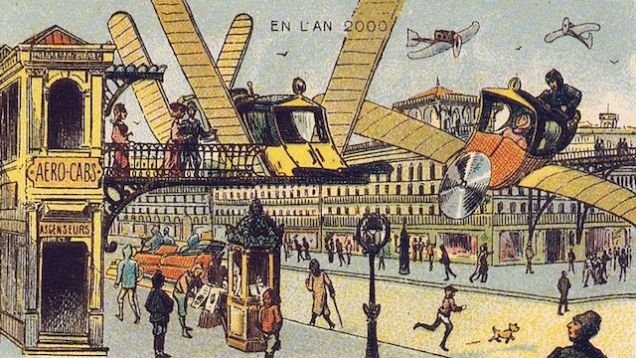
Half a century later American illustrator Arthur Reidbo portrayed his vision for the future of the "sunmobile" - without wings, but on solar panels similar in appearance to modern satellite dishes.
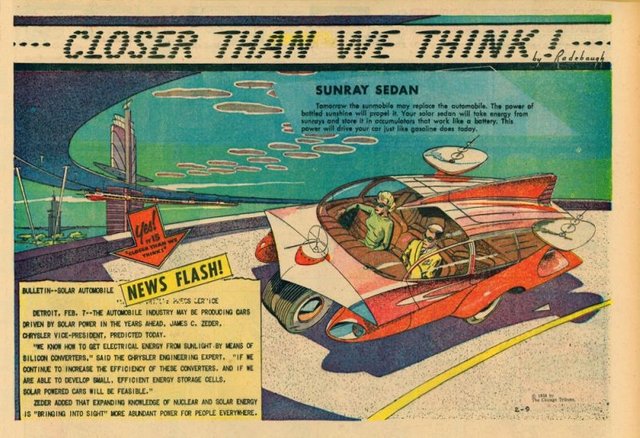
Modern futurists have more space for fantasies, because many technologies are already transforming the capabilities and appearance of personal transport. Extrapolate their influence over the next 50 years - much easier than coming up with a car of the future from nothing. Artificial intelligence and autopilotation associated with its development, virtual reality, research of alternative types of energy production, and finally, flight opportunities, which are so lacking in urban traffic jams - we will consider what technologies already allow and what remains in the conduct of science fiction.
What will they ride on?
The main directions for the transport fuel of mass cars, alternative oil and gas, now two - electric cars and cars on hydrogen fuel. The movement towards electric cars is only just beginning. Despite the popularity of the culture of responsible consumption, in past years the share of electric cars sold, for example, in the US, did not reach 2%.
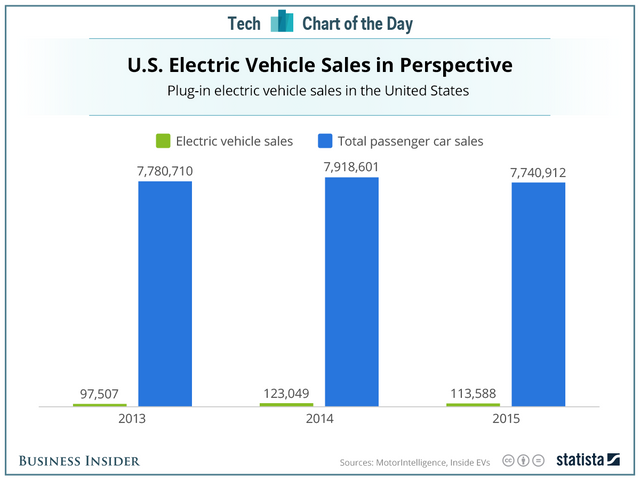
According to Bloomberg forecasts, after 8 years, electric cars will be cheaper than gasoline cars. Now for an e-mobile, about half the price is the cost of a battery, and it decreases every year and by 2025 will fall below $ 30,000, breaking the "psychological threshold".
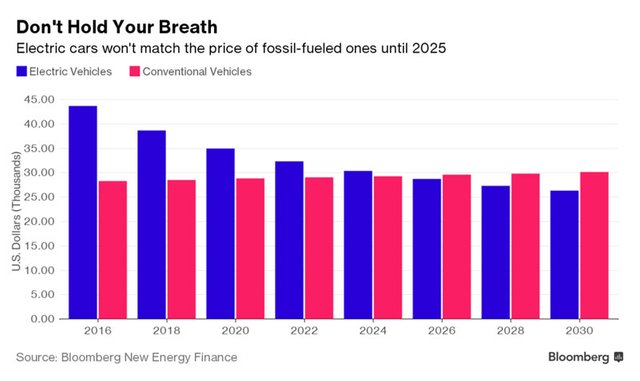
About the electric cars and their future is not just talking lazy. Many national laws provide tax incentives for buyers of such cars. And Ukraine is discussing the abolition of VAT and duties - according to statistics of the Ministry of Internal Affairs, for the first quarter of 2017 in Ukraine registered only 548 electric cars. But the authorities already promise to reduce prices by 40%, introduce incentives for owners in the form of free parking and permission to travel on public transport lanes.
While optimists are happy about the move towards an environmentally friendly future, while pessimists gloat over Tesla's billion-dollar losses, another type of alternative energy for cars - hydrogen fuel - can be considered. As the employee of the Kurdyumov Institute of Metal Physics, Ph.D. Vladimir Dekhtyarenko, hydrogen engines operate on the principle of gasoline: on burning fuel.
Hydrogen can be burned:
As hydrocarbons, in the combustion chamber;
In the fuel cells in which the oxidation of hydrogen occurs - energy is released during the reaction.
The second way is safer and more efficient. Dekhtyarenko is just studying materials with which it is possible to store hydrogen for a long time and safely for use in engines. "The complexity of creating auto on hydrogen is, firstly, the generation of hydrogen, and secondly - its safe storage and transportation (hydrogen is a very active element that easily interacts with many metals, leading to their embrittlement and, as a consequence, Destruction), "says the scientist.
Who eventually won - is still unknown. Large brands just in case invest in such developments: earlier this year GM and Honda announced the construction of a factory for the production of fuel cells for future hydrogen cars. A good comparison of electric cars and cars on hydrogen from the point of view of the user leads one of Quora users in the topic "Would people prefer hydrogen cars to gasoline?". But so far, hydrogen cars are losing already at the production stage: if the assembly of a gasoline car in Japan takes 60 seconds, hydrogen is spent 72 minutes. In Japan in the spring of this year, only 1,700 of these vehicles traveled, only 900 refueling stations operated. By the way, Ilon Mask somehow called fuel cells - fuel cells of hydrogen cars - fooling elements, fool cells.

And the second question is how to ensure such autonomy? One of the options - systems like LIDAR (Light Identification Detection and Ranging), which measure the distance around the car with a laser (about LIDAR, we'll talk in more detail in the next material). If, on the basis of laser data, cameras and the work of smart software, the auto builds a 3D map of the locality, it is theoretically enough that the machine can take control over itself.

Many automakers - including Tesla and Volvo - are in favor of partial autonomy at this stage in the development of auto-piloted vehicles. Lex Kessermakers, CEO of Volvo Cars in North America, believes that the autopilot does not mean the immediate departure of the traditional helm in history. One of the projects of the company is the study of the possibilities of the future car, its concept called Concept 26, provides that the driver himself chooses, drives him or trusts the autopilot, besides, he promises the option of previewing the maneuvers of the autopilot.
The concept of such a car implies three autonomous modes:
At the wheel, the driver is fully focused on the road.
In work - the driver can afford to work on a laptop or make a couple of calls without leaving the driver's seat.
On vacation - the driver leans back in the chair, the car follows the road. At the same time, the CEO of the company Håkan Samuelsson said earlier that the company is ready to take full responsibility for the behavior of the car in autopilot mode, and that Volvo is the first of the world's automakers to give such a promise.
For several years the company has been carrying out a large-scale DriveMe project, its goal is to give ordinary people a chance to try the trip on autopilot machines in normal conditions.

In 2017, 100 unmanned vehicles will participate in the project, they will drive along the usual suburban roads of Gothenburg with a small number of pedestrians and at a speed of no more than 70 km / h. The purpose of the test is beyond the scope of autopilot tests. The data collected within DriveMe will help to understand how autopilot mode affects fuel consumption, traffic and traffic jams, and even how it can change the city's infrastructure.
To study the possibilities of autopilot in machines, neural networks are being trained - for example, to recognize "raw" images of objects from cameras and convert this information into control commands. These objects can be: road markings, road signs, cars, pedestrians, etc. And training of such systems is not only engaged in car manufacturers - this is the scientific work of Nvidia employees following the results of training a neural network, accustomed to recognize the image of the camera so as to change the angle of the helm. But the video, where the machine at a speed is controlled by Nvidia's neural network PilotNet:
Augmented and virtual reality
According to IDC, in 2017, global investment in the development of virtual reality solutions and its relative - augmented reality - will double and amount to almost $ 14 billion, and until 2020 will grow to $ 143 billion. The automotive industry will certainly invest in this figure.
Every year in the United States is the largest exhibition of consumer electronics - CES and only this year just three manufacturers presented their concepts of augmented reality in cars. Harman showed the potential of the LIVS system in the modified Chrysler Pacifica. It displays information about speed in front of the driver's eyes, marks the nearest cars and road signs with markers (which will help if they are not clearly visible, they are hidden by greens, etc.). The demo of the similar system was shown also by the company Continental: the projector DigiLens projects a lot of information on the windshield, helping the driver to navigate.
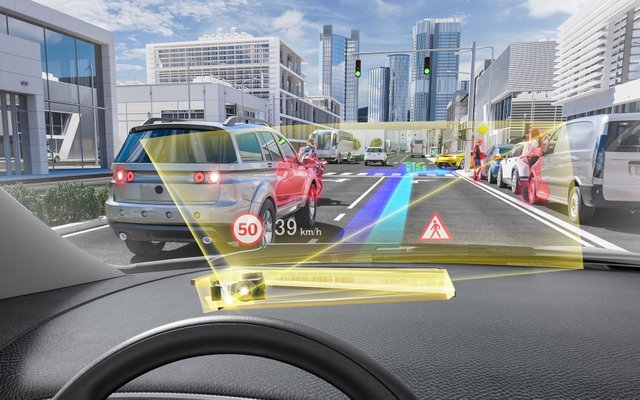
The same company, by the way, is developing a system for starting a car on fingerprints and authorizing a driver for face recognition.
If the augmented reality in the auto industry, first of all, helps the driver to navigate the road, virtual reality will be connected already at the stage of car selection and test drives. For example, Rewind created a fully interactive VR simulator under the Oculus Rift DK2 for one of the Lexus models.

The automakers themselves are aware of the need for new interfaces and ways to "communicate" the driver with the car. For example, in May this year, Volvo announced a partnership with Google - its goal is to create a new information, entertainment and communication system based on Android. It should appear in new Volvo models in two years. How it can work - you can look at the video:
What will happen in the end
If you fantasize, after decades to choose and try yourself a car can be in a virtual auto show, the autopilot in it will cease to be a curiosity, the driver will receive additional interfaces to the car, important data about the road right before your eyes and, possibly, a voice assistant like Siri, who Help drive the car.
We completely forgot: the cars of the future, it is possible, will fly - now several companies are developing mass models right away - Uber is working on Elevate flying taxis, the Netherlands PAL-V in February this year opened pre-order for a vehicle that knows how to ride and Fly, the German Lilium has already carried out successful tests of the airmobile flight.
Instead of the results or conclusions, you can try to imagine how personal transport will change not in 20 or 50 years, but in the era of interplanetary flights. After all, how much time passes, people will always be drawn to travel.
Post created by @hrytsenko